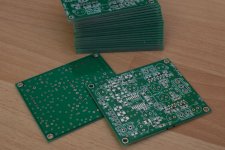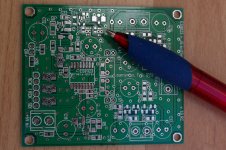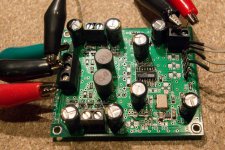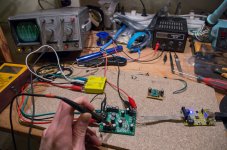Update: boards arrived!
Dear all,
I'd like to send a little update about my version of ES9023 + JG filter buffer PCB.
Proto-boards arrived today so betatest can start soon. They look really good, though next time I'll take into account vias conflicting with silkscreen
Unfortunately a flu knocked me down so it may take a few days until I start contacting the beta tester and stuffing a first board (soldering those tiny smd stuff isn't fun if the head is completely mucus-ridden ). I'll keep you updated!
). I'll keep you updated!
Best regards, Daniel
Dear all,
I'd like to send a little update about my version of ES9023 + JG filter buffer PCB.
Proto-boards arrived today so betatest can start soon. They look really good, though next time I'll take into account vias conflicting with silkscreen
Unfortunately a flu knocked me down so it may take a few days until I start contacting the beta tester and stuffing a first board (soldering those tiny smd stuff isn't fun if the head is completely mucus-ridden
 ). I'll keep you updated!
). I'll keep you updated!Best regards, Daniel
Attachments
Update: 1st board up and running
Hi all,
today I managed to stuff one board and do some first tests. Everything works right from the first start
I used asynchronous mode with 48MHz clock and fed the DAC with miniSTREAMER. Today I only checked with 1kHz and 10kHz sine and scope (signals look really good!). Tommorow i'll do some more measurements with soundcard (FFT, THD,...) and more important some listening
Best regards, Daniel
Hi all,
today I managed to stuff one board and do some first tests. Everything works right from the first start
I used asynchronous mode with 48MHz clock and fed the DAC with miniSTREAMER. Today I only checked with 1kHz and 10kHz sine and scope (signals look really good!). Tommorow i'll do some more measurements with soundcard (FFT, THD,...) and more important some listening
Best regards, Daniel
Attachments
ES9023 + JG Filter Buffer rocks
Just listened to some good music with my old Sennheiser headphones. The buffer drives them really good and the sound is awesome
No noise, great dynamics, bass is full and punchy, mids are airy and I really loved the highs - detailed and crisp but primarily sooo sweet and round (of course I am heavily biased ). This cheap DAC plus the Buffer is really good! A big thanks to Joachim for making this available!
). This cheap DAC plus the Buffer is really good! A big thanks to Joachim for making this available!
Best regards, Daniel
Just listened to some good music with my old Sennheiser headphones. The buffer drives them really good and the sound is awesome
No noise, great dynamics, bass is full and punchy, mids are airy and I really loved the highs - detailed and crisp but primarily sooo sweet and round (of course I am heavily biased
Best regards, Daniel
Headphones vs V
I'll ask the stupid question, will the output of this FET stage {into headphones} increase with V? More slam? Daniel may still be running 9Vx2... yet.
I find that on "hot" recordings I have to turn down the digital volume on ES9023 or it clips [even at 3.6V with 100K to ground on pin#6]. After that it's a wonderful DAC chip for the price! I am anxious to try the filter buffer, I have one filter 90% done in a AC wiring box [just the filter] to experiment with in front of other gear I own, and after some DACS, obviously.
I'll ask the stupid question, will the output of this FET stage {into headphones} increase with V? More slam? Daniel may still be running 9Vx2... yet.
I find that on "hot" recordings I have to turn down the digital volume on ES9023 or it clips [even at 3.6V with 100K to ground on pin#6]. After that it's a wonderful DAC chip for the price! I am anxious to try the filter buffer, I have one filter 90% done in a AC wiring box [just the filter] to experiment with in front of other gear I own, and after some DACS, obviously.
It's a Sennheiser HD480 classic (100Ohm). On Monday i'll test with Sennheiser HD650 and compare with electrostatic phones from Sennheiser with HEAD acoustics PEQ V with PVA IV.3 (it's a bit unfair).
Best regards, Daniel
I wonder if anyone with access to proper measurement equipment could run and publish some performance measurements for Daniel's board (THD+N, IMD, DNR etc.) ?
That would indeed be quite interesting
I already did some first measurements with my build but did not save the graphs (Arta Demo -> only screenshots). With my RME DIGI 96/8 PAD I measured a THD+N around 0.0058 (-103dB) with 96kHz I2S Input (not U.Fl but pinheader) from miniSTREAMER (TE7022) *. Hard to interpret though since there are too many variables. I don't have a low THD generator at hand to test the ADC of the RME card. In loopback (incl. soundcards DAC) THD is (only) slightly better.
Best regards, Daniel
*There might also be some potential to improve the miniSTREAMER or asynchronous USB solutions might also be better
Thanks Daniel. It does look promising. I would still love to see someone run a similar testing methodology like nwavguy did for the ODAC. I know it is a long shot to ask as it would require time and access to a professional grade equipment. If your BOM is finalized and replicable, the test results could provide a good indication of what we can practically achieve with the board.
BTW, are you planning to give this specific board a code name?
I think I'm going to get one piece to try out. Just worried about replicating that ES9023 soldering feat in your photo.
BTW, are you planning to give this specific board a code name?
I think I'm going to get one piece to try out. Just worried about replicating that ES9023 soldering feat in your photo.
Orangeart,
the build-thread you seek is at:
http://www.diyaudio.com/forums/digi...-thread-es9023-jg-buffer-boards-betatest.html
the build-thread you seek is at:
http://www.diyaudio.com/forums/digi...-thread-es9023-jg-buffer-boards-betatest.html
I have been asked by PM whether the 9022 as I posted here can be used with the Amanero.
The ES9022 module I designed has a low-jitter XO next to it, as it should be.
For the likes of QA550, the XO frequency is divided down 4x to also drive the dsPIC.
So there is no synchronization problems between the two, and the DAC takes the clock directly from the XO.
This is our preferred solution.
The Amanero has dual clocks of different frequencies which are switchable according to the music.
It then outputs this clock signal also to the DAC. But the clock signal does seem to go through the MCU.
To use this with the ES9022, the 9022 either has to received thre MCLK from the MCU.
Or alternatively it has to use a say 50MHz XO and then do asynchronous clocking.
None of the above I consider the ideal solution.
The ideal solution would be have 2x XO next to the DAC.
Select them with a logic line from the MCU, and output the XO to both the DAC and the MCU.
This solution requires different hardware, and hence cannot be done as a stand-alone solution.
If you have an Amanero, and want to use the ES9022, the easiest way would be to use the Amanero to drive the MCLK of the DAC.
All you need then is a SOIC16 to DIP16 adaptor board and some P2P wiring.
Try this for yourself first.
Patrick
The ES9022 module I designed has a low-jitter XO next to it, as it should be.
For the likes of QA550, the XO frequency is divided down 4x to also drive the dsPIC.
So there is no synchronization problems between the two, and the DAC takes the clock directly from the XO.
This is our preferred solution.
The Amanero has dual clocks of different frequencies which are switchable according to the music.
It then outputs this clock signal also to the DAC. But the clock signal does seem to go through the MCU.
To use this with the ES9022, the 9022 either has to received thre MCLK from the MCU.
Or alternatively it has to use a say 50MHz XO and then do asynchronous clocking.
None of the above I consider the ideal solution.
The ideal solution would be have 2x XO next to the DAC.
Select them with a logic line from the MCU, and output the XO to both the DAC and the MCU.
This solution requires different hardware, and hence cannot be done as a stand-alone solution.
If you have an Amanero, and want to use the ES9022, the easiest way would be to use the Amanero to drive the MCLK of the DAC.
All you need then is a SOIC16 to DIP16 adaptor board and some P2P wiring.
Try this for yourself first.
Patrick
- Status
- This old topic is closed. If you want to reopen this topic, contact a moderator using the "Report Post" button.
- Home
- Source & Line
- Digital Line Level
- Anybody using the new ESS Vout DAC (ES9022)?



